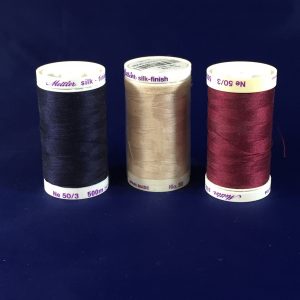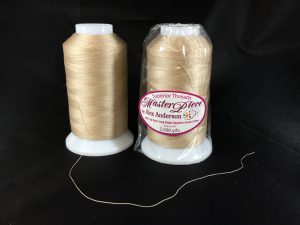My journey with piecing thread is probably much like yours. In the beginning of learning to sew I wasn’t sure I wanted to invest lots of money in the craft of quilting. I had another hobby at the time (scrapbooking because I am addicted to photography) and I already had lots of money invested in those supplies. I did what anyone with an awesome Mom would do, I borrowed her supplies.

My Mom is an accomplished sewer/sewist/seamstress and so had lots of spools of thread lying around. I only needed some thread to run through my (also borrowed) sewing machine and didn’t really care about anything but color. I grabbed something off of her wall that looked like the right basic color to piece with and went to it. Being an inexperienced sewer, I didn’t really think about running out of thread and needing to buy more. I had never seen anyone “run out of thread” before.
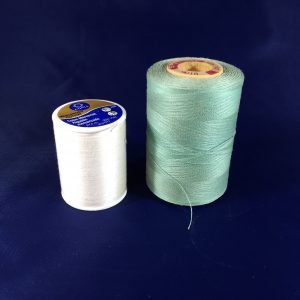
Once I realized that quilting was for me… I began to acquire. First the sewing machine, then the fabric (which up until then I also “borrowed from Mom”) and then thread. I was so shocked the first time I had to buy thread. It’s a little bit expensive. I was cautioned away from purchasing some of the less expensive variety available at my local Joann’s store and opted for a reasonable priced Mettler on the little spools in a couple of colors. I thought I was set.
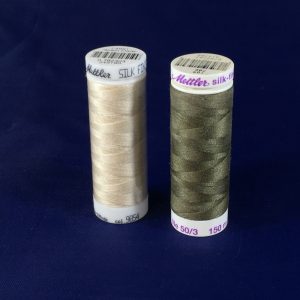
Imagine my surprise when I started piecing large tops and suddenly… ran out. Those little spools that I thought would last forever… were now just a small plastic spool covered in cotton dust. I actually used a whole spool of thread. So I started purchasing the large (still small) spools in the basic colors. Then… I got a thread stuck in my sewing machine around the bobbin case… and had to open the machine and dig it out. Oh my. I had no idea that machines collected lint. The inside of my machine looked like the inside of my dryer vent.
That’s when I started doing a little more research about the types of thread I use. After joining a quilting guild and taking classes and learning more and more about quilting I realized how little I knew about thread. There are so many types on the market. One of my quilting buddies introduced me to the thread wall at my local quilt shop and I tried Aurifil. I was hooked. All the lovely colors, not nearly as much lint and my stitches looked dreamy.
Your Aurifil dealer can be like a drug dealer. Soon one spool wasn’t enough. I needed a cone. I developed an addiction to thread. Luckily the cones last quite a long time and you really only need a couple of colors. I use a buff color for the majority of my piecing. I use a darker gray for black fabric. Sometimes white for white piecing but mostly just buff. That buff color is really all you need if you are a basic girl like me.
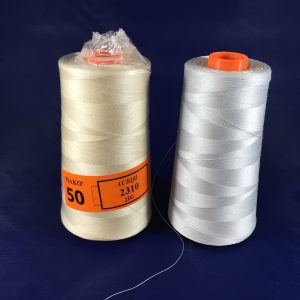
I like the thread to be sturdy so it doesn’t fray in the needle. I need a thread that doesn’t create much lint (or dust) and I clean my machine continuously to make sure I don’t have any fuzz balls in the bottom or the top. Over the years I have narrowed down a few brands that seem to work perfectly for me and that I know I can get at just about any quilt shop or online. I also feel the thread (like I feel my fabric) and ask the salesperson about their experience with the thread. Usually you can tell by the questions you ask whether they have ever actually used the thread before, whether or not they like it and what their opinion would be for an alternative brand.
When testing a new thread, start with a small spool. I know it’s tempting to take advantage of a sale or buy a much bigger cone because the price per yd is better. BUT…err on the side of caution. I can assure you that you will thank me for that advice the first time you buy an expensive small spool of thread and get it home only to find that it wreaks havoc in your machine, breaks all the time, or just doesn’t quite feel or look right.
Currently I piece all my quilts on either a Bernina or Janome sewing machine and those two machines don’t usually have a problem with any thread. I’m still careful when it comes to spending my money. I buy in big cones and like to make sure that I will have the best experience from one end of the cone to the other.
My favorite piecing threads at this time: Aurifil 50wt Mako Cotton (#2310 Light Beige) and Masterpiece 50wt Extra-Long Egyptian Cotton by Alex Anderson for Superior Threads (#153 Parchment).
Of course, I am always willing to try something new for piecing and give an opinion here or there. I prefer #50 or 50wt for piecing. There are lots of opinions on this topic and I suggest you do a little research for yourself. It never hurts to try.
The pros over at Craftsy say, “If you are using a high quality quilting fabric, be sure to piece with a high quality thread.” I agree with that statement. You spend so much on your fabric you shouldn’t skimp on your thread. We spend lots of time and money on these quilts and we want every aspect of them to last. That includes the machine/ hand quilting stitches as well. You can read more from Craftsy HERE.
Quilter’s World: The Magazine for Today’s Quilter gave this advice…
- For most piecing, good-quality cotton or cotton-covered polyester is the thread of choice. Inexpensive polyester threads are not recommended because they can actually cut the fibers of cotton fabrics.
- Use the best quality thread you can find. Inferior cotton threads create a lot of lint, especially when machine-sewing. This lint gathers in the sewing machine’s moving parts and creates problems. Avoid bargain threads. They are not usually durable in the finished product.
- Choose thread colors that will match or blend with fabrics in your quilt. If using dark fabrics, a dark gray would be a good choice. If using light fabrics, off-white blends well. When making scrap quilts of many colored fabrics, choose a neutral thread, such as medium gray.
- The threads should not be seen when pulling at seams. If using a light thread when sewing dark fabric patches, the thread will probably show when the seam is pulled. Test a sample seam to prevent this problem.
They have lots of advice on quilting products and you can read all about it HERE.
Most quilt professionals are going to recommend at 50wt thread (depending on the brand) for quilting and they will always recommend using a 100% cotton thread for piecing. Something thick enough to be sturdy but not so thick that you see the stitches after pressing. Also choose the right color. The color doesn’t have to match your project but should blend well. That is the reason I choose the colors I do.
Next post we will talk about another type of thread. But for now, tell me your favorite brand of thread for piecing and the color you use. I will post the results in the next article. Hopefully we can all learn a little bit from each other.
